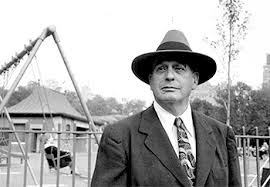 |
| Jane Jacobs vs. Robert Moses bigtink.com |
Before we begin our discussion on Jane Jacobs and Robert Moses, yours truly just wants to express the undying gratitude over reaching 70,000 page views. You all are the very best audience a person can have. Thank you all. Now on to the epic battle between the planner and the critic in early sixties New York.
Lauren Walser of the National Trust for Historic Preservation recently recalled the epic battle waged between Robert Moses, the New York City Parks Commissioner, and Jane Jacobs over a proposed highway that would cut through Ms. Jacobs's beloved Greenwich. Her article "A Tale of Two Planners: Jane Jacobs vs. Robert Moses," examines the different approaches each took in imagining the future of New York City. The proposed highway, the Lower Manhattan Expressway, would have cut through Broome Street, transforming Lower Manhattan into a 10-lane elevated highway. The highway would have "...cut through SoHo and Little Italy, destroying Washing Square Park, demolishing numerous building and displacing thousands of families and businesses." The plans had been on hold for a long time but, in the early sixties, they were once again put in motion.
 |
| Proposed Cross Manhattan Arterials citylab.com |
 |
| Washington Square Park with highway lane nypl.org |
[Robert Moses and Jane Jane Jacobs] kind of circled around each other like tigers in a cage..They were just extraordinary adversaries.
Using the sport of boxing as a metaphor, Ms. Walser writes, "In this urban theory boxing ring, we have, in one corner, Robert Moses, a larger-than-life personality with endless drive and a,bitten and a remarkable ability to navigate backroom politics." Mr. Flint added, He was a go getter from the beginning.
 |
| Robert Moses gothamgazette.com |
Robert Moses was born in New Haven, Connecticut and was brought to New York City as a child. He was educated at Yale, Oxford, and Columbia University. Mr. Moses was New York City Parks Commissioner from 1934 to 1960. He never held an elected office, at one point he juggled twelve different appointed position simultaneously. Robert Moses had great plans for what New York City could be and knew how to bring his vision to fruition. While most adjectives used to describe Mr. Moses have been less than flattering but this "master builder" exerted his influence to transform the City, building highways, bridges, tunnels, public housing developments, playgrounds, and park.
 |
| Jane Jacobs quote azquotes.com |
In 1961, Jane Jacobs published her iconic book The Death and Life of Great American Cities. The books challenged the "short-sightedness of modern urban planning and used her own observations and experiences to conclude what makes a good, safe, livable, desirable neighborhood: smart growth, mixed-use facilities, small city blocks, transit-oriented planning, sufficient density of people and buildings, and a mix of old and new buildings."
| Jane Jacobs at a protest burnhampton100.lib.uchicago.edu |
Government and developers are now listening to the people...We have Jane Jacobs to thank for that.
Robert Moses and Jane Jacobs were different as night and day. Mr. Moses was an Ivy-League Ph.D in political science and Ms. Jacobs did not have a college degree or any sort of training in urban planning. She detested the top-down, backdoor approach to urban planning-the very method that Mr. Moses was quick to deploy. Jane Jacobs was a populist, fighting for the people, specifically for pedestrians. Robert Moses was said to favor automobiles over people and in many cases, his plans reflected this preference in the way they displaced people.
 |
| A Marvelous Order mosesjacobsopera.com |
This populist versus elitist dynamic (echoed in the current election cycle) has taken hold of the public imagination. Last month witnessed the premier of A Marvelous Order, (http://mosesjacobsopera.com/index.html)a much talked about opera about the Jane Jacobs-Robert Moses battle over lower Manhattan in the sixties. When Blogger first heard the murmurings of the opera through the usual social media sources, your truly blanched at the notion. The Carnegie Museum of Art's Heinz Architectural Center recently closed, HACLab Pittsburgh" Imagining the Modern (http://www.cmoa.org/haclab.pittsburgh/). This was an experimental exhibition that examined post-war architecture and urbanization in Pittsburgh. Part of the exhibition looks at how the Pittsburgh Regional Planning Association hired Robert Moses to resolve traffic congestion problems in the downtown area in 1939. Mr. Moses proposed the "Arterial Plan for Pittsburgh," which led to the Penn-Lincoln Parkway, the Crosstown Boulevard, and the Point State Park-setting the stage for future development.
 |
| HAC Lab Pittsburgh press.cmoa.org |
Over twenty years later, the University of Pittsburgh invited Jane Jacobs to consult in the city. Ms. Jacobs was taken on a drive through the city's urban renewal projects, harshly declaring,
Pittsburgh is being rebuilt by city haters.
Despite or inspire of their differences, both Robert Moses and Jane Jacobs wanted the same thing, a better city. A better city defined by Ms. Jacobs "...meant human-scale neighborhoods, where community members played an active role in shaping their environment. For Moses, that meant having strong infrastructure and a plan for density."
Anthony Flint had this to say,
Moses realize the importance of infrastructure and of planning at a regional scale. And he was able to navigate the bureaucracies, particularly with fundraising...Jacobs was the spokesperson for the human-scale neighborhood and for remembering how people actually function in urban environments. They brought different things to the table. But they had the future of the city very much at heart.
No comments:
Post a Comment